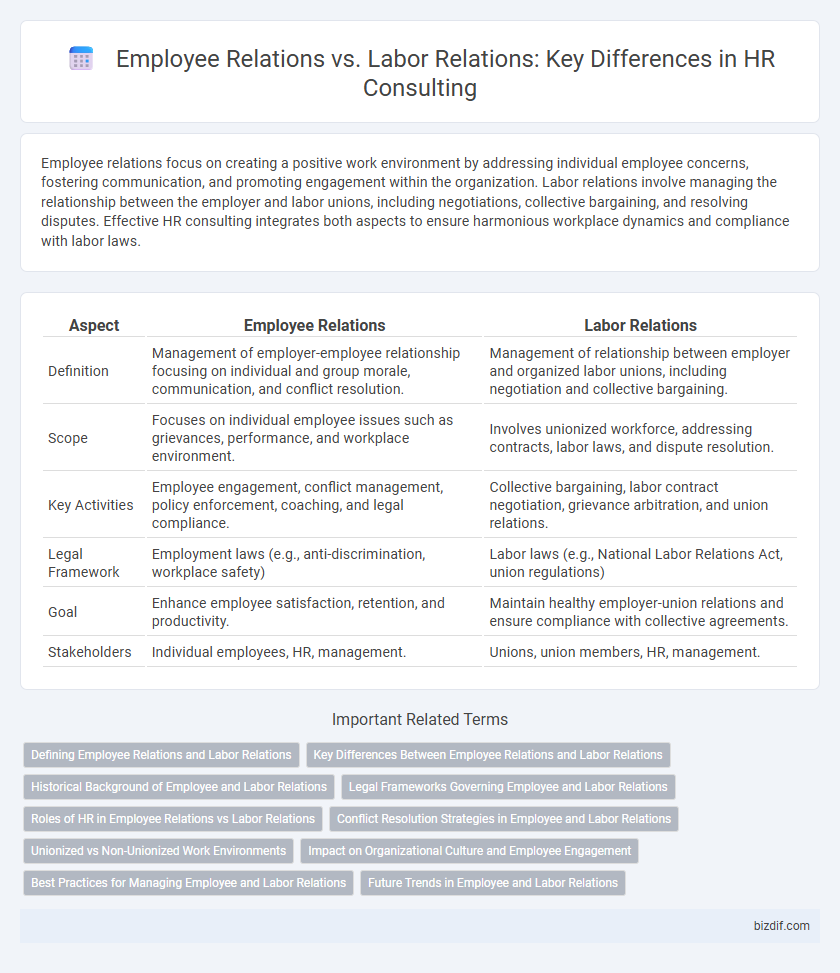Employee relations focus on creating a positive work environment by addressing individual employee concerns, fostering communication, and promoting engagement within the organization. Labor relations involve managing the relationship between the employer and labor unions, including negotiations, collective bargaining, and resolving disputes. Effective HR consulting integrates both aspects to ensure harmonious workplace dynamics and compliance with labor laws.
Table of Comparison
| Aspect | Employee Relations | Labor Relations |
|---|---|---|
| Definition | Management of employer-employee relationship focusing on individual and group morale, communication, and conflict resolution. | Management of relationship between employer and organized labor unions, including negotiation and collective bargaining. |
| Scope | Focuses on individual employee issues such as grievances, performance, and workplace environment. | Involves unionized workforce, addressing contracts, labor laws, and dispute resolution. |
| Key Activities | Employee engagement, conflict management, policy enforcement, coaching, and legal compliance. | Collective bargaining, labor contract negotiation, grievance arbitration, and union relations. |
| Legal Framework | Employment laws (e.g., anti-discrimination, workplace safety) | Labor laws (e.g., National Labor Relations Act, union regulations) |
| Goal | Enhance employee satisfaction, retention, and productivity. | Maintain healthy employer-union relations and ensure compliance with collective agreements. |
| Stakeholders | Individual employees, HR, management. | Unions, union members, HR, management. |
Defining Employee Relations and Labor Relations
Employee Relations focuses on managing the day-to-day interactions between employers and individual employees, emphasizing communication, conflict resolution, and employee satisfaction. Labor Relations pertains to the collective relationship between employers and labor unions, dealing with collective bargaining, union contracts, and labor laws compliance. Both areas are crucial for fostering a productive workplace but target different aspects of workforce management.
Key Differences Between Employee Relations and Labor Relations
Employee Relations centers on managing the direct relationship between employers and individual employees, emphasizing communication, conflict resolution, and employee engagement to foster a positive workplace environment. Labor Relations involves negotiations and interactions between management and organized labor unions, focusing on collective bargaining, contract administration, and compliance with labor laws and union agreements. Key differences include the scope of interaction--individual versus collective--and the legal frameworks governing union presence and collective negotiations.
Historical Background of Employee and Labor Relations
Employee relations and labor relations both stem from distinct historical contexts shaping workplace dynamics; employee relations evolved from individualized management practices focusing on motivation and communication within organizations, whereas labor relations originated from the labor union movements in the late 19th and early 20th centuries advocating collective bargaining and workers' rights. The rise of industrialization prompted labor relations to address conflicts between employers and organized labor, influencing labor laws and the establishment of labor boards. In contrast, employee relations expanded as businesses recognized the importance of fostering positive work environments and addressing individual employee needs beyond union negotiations.
Legal Frameworks Governing Employee and Labor Relations
Employee relations primarily involve managing interpersonal relationships and workplace culture within an organization, governed by internal policies and employment laws such as the Fair Labor Standards Act (FLSA) and the Equal Employment Opportunity Commission (EEOC) guidelines. Labor relations focus on the collective relationship between employers and labor unions, regulated by statutes like the National Labor Relations Act (NLRA) and the Labor Management Reporting and Disclosure Act (LMRDA). Understanding these distinct legal frameworks ensures compliance and effective conflict resolution in HR consulting practices.
Roles of HR in Employee Relations vs Labor Relations
HR plays a pivotal role in employee relations by fostering positive workplace culture, addressing employee grievances, and ensuring compliance with labor laws to enhance job satisfaction and productivity. In labor relations, HR acts as the intermediary between management and labor unions, negotiating collective bargaining agreements, resolving disputes, and managing union compliance issues. Effective HR management balances individual employee needs with collective labor interests to maintain organizational harmony and legal conformity.
Conflict Resolution Strategies in Employee and Labor Relations
Effective conflict resolution strategies in employee relations prioritize open communication channels, mediation, and timely intervention to address workplace disputes before escalation. In labor relations, conflict resolution often involves collective bargaining, arbitration, and adherence to labor laws to resolve disputes between unions and management. Both approaches emphasize proactive problem-solving to maintain a positive work environment and ensure compliance with organizational policies and legal standards.
Unionized vs Non-Unionized Work Environments
Employee relations focus on managing workplace dynamics and resolving issues in non-unionized environments by fostering communication and employee engagement. Labor relations specifically deal with unionized work settings, where negotiations, collective bargaining, and compliance with labor laws are critical. Effective HR consulting differentiates strategies to enhance workplace harmony and legal adherence based on whether the environment is unionized or non-unionized.
Impact on Organizational Culture and Employee Engagement
Employee relations prioritize fostering positive interactions and communication between management and individual employees, which enhances organizational culture by promoting trust, transparency, and job satisfaction. Labor relations concentrate on managing collective bargaining and union dynamics, directly influencing organizational policies and workplace stability. Both approaches significantly impact employee engagement, with effective employee relations boosting morale and retention, while strong labor relations ensure fair treatment and conflict resolution.
Best Practices for Managing Employee and Labor Relations
Effective management of employee and labor relations involves fostering open communication channels, promoting mutual respect, and implementing clear conflict resolution policies to address workplace issues promptly. Utilizing regular training programs and employee engagement surveys helps identify and mitigate potential disputes, enhancing organizational stability and productivity. Compliance with labor laws and collaborative negotiation with unions ensure fair treatment, reduce grievances, and support a positive work environment.
Future Trends in Employee and Labor Relations
Emerging trends in employee relations emphasize the integration of artificial intelligence and data analytics to personalize workplace engagement and address employee concerns proactively. Labor relations are shifting towards collaborative bargaining involving technology-driven negotiation platforms that enhance transparency and efficiency in union interactions. Both domains will increasingly adopt hybrid work models and well-being initiatives to align with evolving workforce expectations and regulatory frameworks.
Employee Relations vs Labor Relations Infographic

 bizdif.com
bizdif.com